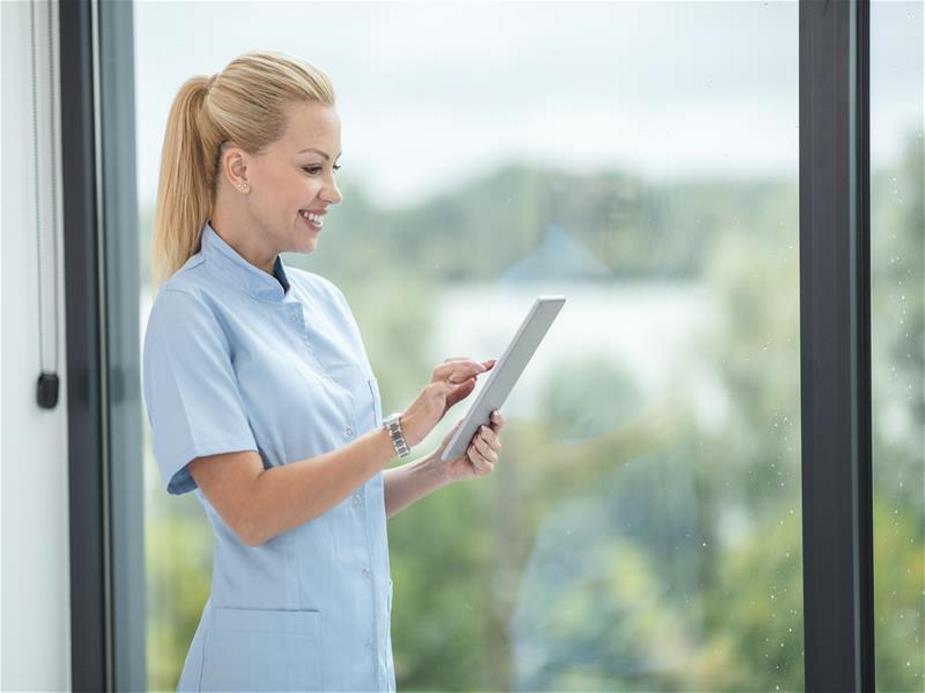Toolkit: How do you use healthcare technology intelligently?

A smart walker, a plaster that monitors sugar levels, computer games as part of rehabilitation? Technology has become an integral part of healthcare too. Technology has become an integral part of healthcare. Healthcare technology – or e-Health – has many benefits: it helps patients actively participate in their recovery, it improves information sharing, it saves money and makes healthcare more accessible. But as a healthcare professional, how do you find the right tools for your patients? And what tools are currently available? Answers to these and many more questions on the topic are provided in a new three-lesson toolkit available to teachers and students of healthcare courses.
“Healthcare professionals see the benefits of using technology, but sometimes they don’t know how. Which tools should they choose? What is best suited to their patient, the phase of treatment, the nature of the illness?” Martijn van der Ent, Researcher within the Rehabilitation and Technology research group, is one of the initiators of the toolkit. “Care providers are open to it, but don’t always know how to approach it. We came up with a toolkit with which lecturers can prepare the healthcare professionals of the future for the use of e-Health.
Petra Siemonsma, Researcher within the Eigen Regie bij Fysiotherapie en Beweegzorg (Taking Control in Physiotherapy and Exercise Care) research group of the Leiden University of Applied Sciences, is also involved in the development of the toolkit and sees many possible applications of care technology in nursing and rehabilitation practice. “Imagine that a patient says: ‘My back is bothering me so much that I can’t get out of bed in the morning’. As a healthcare student or professional, you’ll interpret this as morning stiffness, a complaint associated with osteoarthritis. Based on that first thought, you’ll then proceed to ask questions and do tests in a number of phases. By doing so, you are trying to find out if this patient really has osteoarthritis or if there is something else wrong with him, so that you can then take action or give the patient advice. To support this process – clinical reasoning – you can use care technology at every stage. For example, you could use a smart walker, an app with information about osteoarthritis, a wearable device that registers activity or big data analytics”.
Toolkit
The toolkit consists of 3 lesson plans.
- The first lesson plan provides an overview to orientate you in the world of healthcare technology. Which technology can be used for diagnosis, monitoring or intervention?
- The second lesson plan discusses the criteria that apply to the various technologies. For example, how important is the criterion of privacy if you want to use big data? And for which technology is the safety criterion essential? Would it make your effect measurement less accurate if that state-of-the-art pedometer counted 3 steps too many?
- The third lesson plan helps students and healthcare professionals integrate what they have learned into their own clinical reasoning.
For all healthcare professionals in training
Nowadays, healthcare training at secondary vocational education level (MBO) differs from healthcare training at higher professional education (HBO) or academic (WO) level. And yet only one toolkit was developed? Martijn: “Absolutely, we have developed the toolkit in such a way that every healthcare educator or trainer can use it to develop great lessons, whether they are at MBO, HBO or academic level. The toolkit can also be used when new healthcare technologies come onto the market. We use these lesson plans to meet the needs of both lecturers and students. In the pilot project we carried out among students, the response was often: ‘Oh, but if you apply healthcare technology in this way, perhaps you can also…’ This shows how the toolkit makes subconscious knowledge conscious and provides users with eye-openers. We have also developed alternative teaching formats and created the possibility to differentiate in pace and competence level. As a result, toolkit can be applied flexibly”.
Co-creation
The toolkit was created at the initiative of Martijn van der Ent, Petra Siemonsma and Anne Kruijsen, who, like Petra, are researchers within the Eigen Regie bij Fysiotherapie en Beweegzorg research group of the Leiden University of Applied Sciences. n developing the toolkit, the researchers worked closely with lecturers, other researchers and professionals from healthcare degree programmes and paramedics from, among others, the expertise centre Basalt Den Haag. Basalt is a specialist rehabilitation centre that uses innovative care technology to treat patients.
Enthusiasm is high
The initial response indicates that there is a great deal of enthusiasm for the toolkit. Petra: “We hope that as many people as possible in healthcare training and practice will use it. Once you have used the toolkit, you will notice that you can easily perform your regular care tasks with the help of healthcare technology and that patients can easily get the hang of it too”.